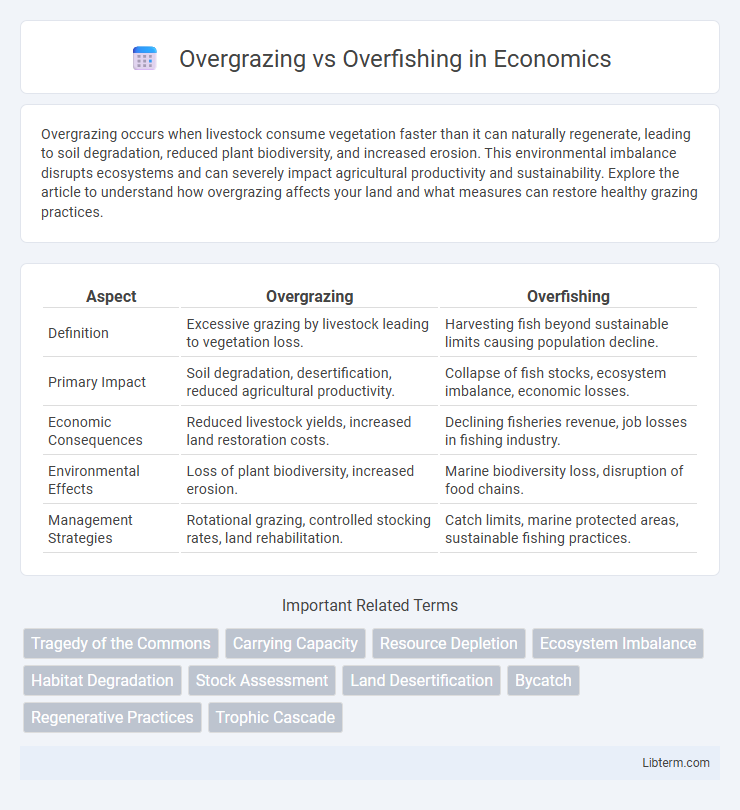Overgrazing occurs when livestock consume vegetation faster than it can naturally regenerate, leading to soil degradation, reduced plant biodiversity, and increased erosion. This environmental imbalance disrupts ecosystems and can severely impact agricultural productivity and sustainability. Explore the article to understand how overgrazing affects your land and what measures can restore healthy grazing practices.
Table of Comparison
| Aspect | Overgrazing | Overfishing |
|---|---|---|
| Definition | Excessive grazing by livestock leading to vegetation loss. | Harvesting fish beyond sustainable limits causing population decline. |
| Primary Impact | Soil degradation, desertification, reduced agricultural productivity. | Collapse of fish stocks, ecosystem imbalance, economic losses. |
| Economic Consequences | Reduced livestock yields, increased land restoration costs. | Declining fisheries revenue, job losses in fishing industry. |
| Environmental Effects | Loss of plant biodiversity, increased erosion. | Marine biodiversity loss, disruption of food chains. |
| Management Strategies | Rotational grazing, controlled stocking rates, land rehabilitation. | Catch limits, marine protected areas, sustainable fishing practices. |
Introduction to Overgrazing and Overfishing
Overgrazing occurs when livestock consume vegetation faster than it can regrow, leading to soil degradation and loss of biodiversity. Overfishing involves harvesting fish at a rate exceeding their natural reproduction, causing population declines and disrupting marine ecosystems. Both practices result in significant environmental damage, threatening the sustainability of terrestrial and aquatic habitats.
Defining Overgrazing: Causes and Consequences
Overgrazing occurs when livestock feed excessively on vegetation, leading to soil degradation, reduced plant biodiversity, and increased erosion. Primary causes include unsustainable livestock densities and poor pasture management, which disrupt natural plant regeneration and soil structure. Consequences of overgrazing impair ecosystem health and agricultural productivity, exacerbating desertification and threatening food security.
Understanding Overfishing: Key Drivers and Effects
Overfishing results from excessive fishing effort that surpasses the reproductive capacity of fish populations, driven by factors such as advanced fishing technology, unregulated fishing practices, and high market demand. It leads to significant declines in fish stock biomass, disrupts marine ecosystems, and threatens biodiversity by altering food webs and habitat structure. The collapse of key commercial fish species highlights the urgent need for sustainable fisheries management and effective regulation to restore ocean health.
Ecosystem Impacts of Overgrazing
Overgrazing severely disrupts terrestrial ecosystems by depleting vegetation cover, leading to soil erosion and reduced soil fertility, which diminishes habitat quality for wildlife. The loss of plant biomass reduces carbon sequestration, exacerbating climate change impacts locally and globally. These disruptions can cause a decline in biodiversity and alter nutrient cycling, impairing ecosystem resilience and function.
Marine Ecosystem Degradation from Overfishing
Overfishing significantly accelerates marine ecosystem degradation by depleting key fish populations, disrupting food webs, and reducing biodiversity. This unsustainable exploitation leads to habitat destruction, such as coral reef damage and altered nutrient cycles, impairing ecosystem resilience. Overfished marine environments experience diminished fish stock recovery, threatening the balance of marine ecosystems and global fisheries sustainability.
Socioeconomic Effects: Land vs. Sea
Overgrazing depletes vegetation, leading to soil erosion and reduced agricultural productivity, which exacerbates rural poverty by diminishing food security and income for land-dependent communities. Overfishing disrupts marine ecosystems, causing fish stock depletion that threatens the livelihoods of coastal populations reliant on fisheries for employment and nutrition. Both practices diminish resource availability, creating socioeconomic instability by intensifying competition and migration pressures in affected regions.
Sustainable Solutions to Overgrazing
Implementing rotational grazing systems and restoring native vegetation promote soil health and prevent land degradation caused by overgrazing. Utilizing controlled stocking rates aligned with carrying capacity preserves biodiversity and supports long-term agricultural productivity. Integrating silvopastoral practices and enhanced monitoring technologies further optimize sustainable land management and ecosystem resilience.
Strategies for Combating Overfishing
Implementing sustainable fishing quotas and creating marine protected areas are essential strategies for combating overfishing. Enforcing strict regulations on fishing gear and seasonal restrictions helps preserve fish populations and marine biodiversity. Promoting community-based management and international cooperation enhances compliance and supports long-term ocean health.
Policy and Regulatory Approaches
Policy and regulatory approaches to overgrazing emphasize land-use planning, grazing limits, and restoration incentives to maintain ecosystem balance and prevent soil degradation. Overfishing policies focus on catch quotas, marine protected areas, and seasonal bans to sustain fish populations and marine biodiversity. Effective enforcement and community engagement are crucial for both sectors to achieve long-term resource sustainability and economic viability.
Comparing Overgrazing and Overfishing: Lessons Learned
Overgrazing and overfishing both lead to ecosystem degradation by disrupting natural population balances and reducing biodiversity, but while overgrazing primarily affects terrestrial habitats by degrading soil quality and vegetation cover, overfishing impacts aquatic environments through the depletion of fish stocks and alteration of marine food webs. Lessons learned from these phenomena emphasize the importance of sustainable management practices, such as rotational grazing in agriculture and catch limits in fisheries, to maintain long-term ecological health. Effective monitoring and enforcement strategies are critical to preventing resource overexploitation and promoting ecosystem resilience across both land and sea.
Overgrazing Infographic

 libterm.com
libterm.com